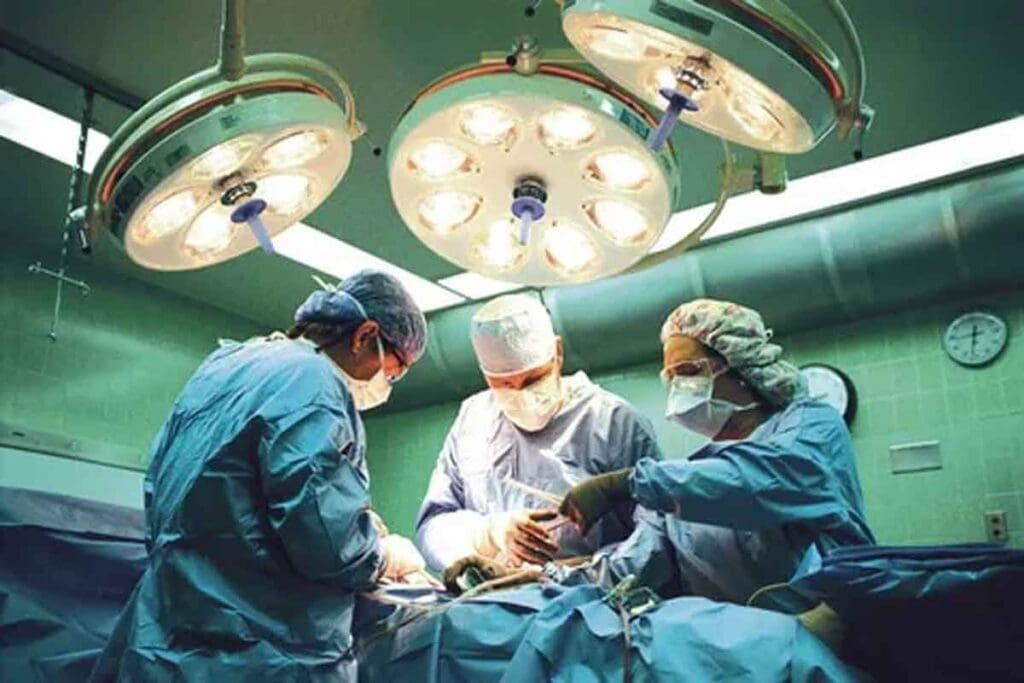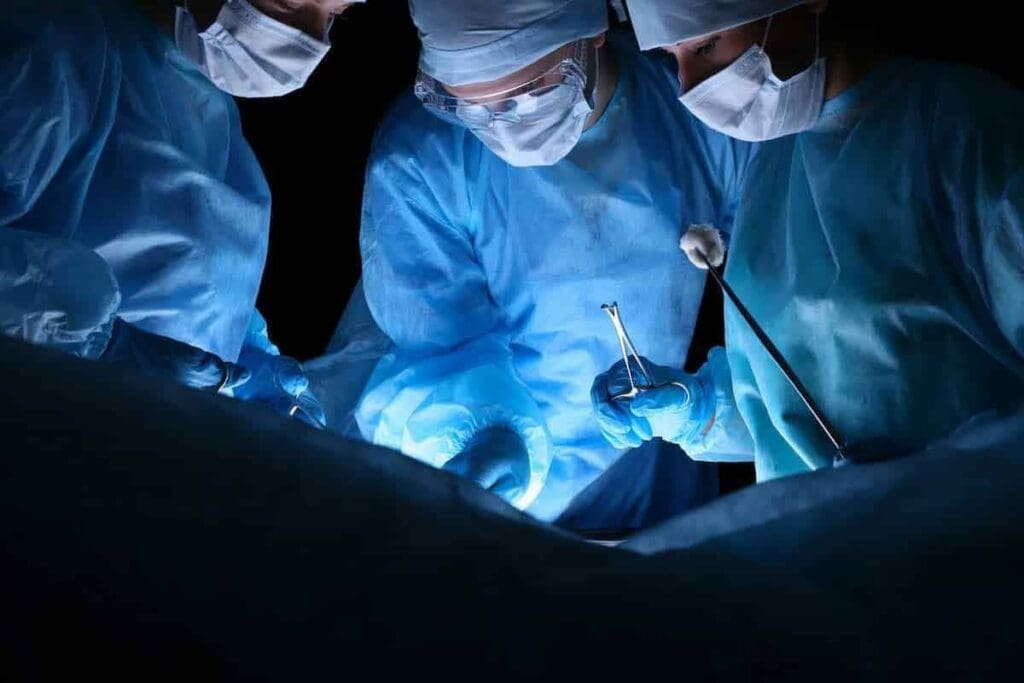Last Updated on November 26, 2025 by Bilal Hasdemir

The treatment of abdominal aortic aneurysms has changed a lot with aortic stent placement. This new method is safer than old surgeries. It’s a big step forward in patient care.
Liv Hospital leads in this new medical area. They focus on quality, new ideas, and following international standards. This ensures the best results in AAA stent graft placement and recovery.
The abdominal aortic aneurysm stent graft is key in treating aneurysms. As technology gets better and more people get aneurysms, the demand for these devices grows.
Key Takeaways
- AAA stent grafts are used in EVAR to treat abdominal aortic aneurysms.
- Aortic stent placement is a minimally invasive procedure.
- Liv Hospital prioritizes quality and innovation in aortic stent placement.
- The global market for abdominal aortic aneurysm stent grafts is expanding.
- Advancements in technology are driving the growth of stent grafts in aorta artery treatments.
The Critical Role of AAA Stent Grafts in Treating Abdominal Aortic Aneurysms

AAA stent grafts play a key role in treating abdominal aortic aneurysms. These grafts are used to address a serious condition. An abdominal aortic aneurysm is when the aorta, the main blood vessel, gets bigger in the abdomen.
What Defines an Abdominal Aortic Aneurysm
An abdominal aortic aneurysm happens when the aorta gets bigger. This is dangerous because it can burst. If it does, it can cause severe bleeding inside the body.
Risk Factors and Prevalence Statistics
Many things can increase your risk of getting an AAA. These include age, smoking, high blood pressure, and family history. Men over 65 are more likely to get it, and smoking makes it even more likely.
Consequences of Untreated AAA
If an AAA is not treated, it can burst. This can lead to deadly bleeding inside the body. The chance of surviving a burst AAA is low. That’s why it’s important to catch it early and treat it with AAA stent grafts.
Essential Fact #1: How AAA Stent Grafts Function as Life-Saving Devices

AAA stent grafts are key in fixing the aorta. They stop it from bursting. These devices are made to treat aortic aneurysms without big surgery.
Engineering Behind Modern Stent Graft Design
Stent grafts mix synthetic materials and metal mesh. They are strong and fit well with the body. The design makes them flexible and strong against blood flow.
Doctors put the stent graft in through a small cut in the artery. It expands to cover the weak spot. This keeps the aneurysm from getting worse.
The Reinforcement Mechanism in the Aorta
Stent grafts make the aorta stronger. They keep the weak spot from bursting. This is done by keeping the aneurysm from getting blood.
This helps the aorta work right. Blood flows through the graft without stressing the weak spot. This lowers the chance of a rupture.
Types of Materials and Configurations
Stent grafts come in many types for different needs. They use strong fabrics and metal stents. This makes them fit well in the body.
- Synthetic Fabric: Stops blood from getting into the aneurysm.
- Metal Stents: Keeps the graft open and in place.
- Customized Configurations: Fits each patient’s body, even complex ones.
New materials and designs have made stent grafts better. They are now a safe choice for treating aortic aneurysms.
Essential Fact #2: Endovascular Aneurysm Repair (EVAR) vs. Traditional Surgery
There are two main ways to treat abdominal aortic aneurysms: Endovascular Aneurysm Repair (EVAR) and traditional surgery. The right choice depends on the patient’s health, the aneurysm’s size and shape, and the risks of each surgery.
Comparing Minimally Invasive and Open Surgical Approaches
EVAR is a less invasive method. It uses small incisions in the groin to place a stent graft. Traditional surgery, on the other hand, needs a big cut in the belly to reach the aorta. EVAR is often chosen because it has fewer risks and quicker recovery times.
“EVAR has changed how we treat abdominal aortic aneurysms,” says a top vascular surgeon. It offers a less invasive option compared to traditional surgery. This change has greatly improved patient outcomes and recovery times.
Benefits of EVAR for Patient Recovery
EVAR offers big advantages for recovery. It’s less invasive, which means:
- Smaller cuts, less damage to tissue
- Lower risk of infections and other problems
- Shorter hospital stays, often just a few days
- Quicker return to normal life, better quality of life
Situations Where Traditional Surgery May Be Preferred
Even with EVAR’s benefits, traditional surgery might be better in some cases. This is true when:
- The aneurysm’s shape or size doesn’t fit EVAR, like a short neck or diseased iliac arteries.
- The aorta’s complex shape can’t be fixed with stent grafts.
- There are doubts about EVAR’s long-term success or the need for frequent check-ups.
In summary, EVAR is great for quick recovery and less invasiveness. But, the choice between EVAR and traditional surgery depends on the patient’s specific situation and the aneurysm’s details.
Essential Fact #3: The Complete AAA Stent Graft Procedure Process
The AAA stent graft procedure has several key steps. It’s a minimally invasive treatment that needs careful planning and precise execution. After the procedure, thorough post-operative care is also essential.
Comprehensive Pre-Operative Assessment
Before the procedure, patients get a detailed assessment. This includes looking at their medical history and imaging studies like CT scans. A systematic review shows this step is vital for identifying risks and checking if the patient is a good candidate.
Step-by-Step Aortic Stent Placement Technique
The aortic stent placement technique has several important steps:
- Administration of local or general anesthesia to ensure patient comfort.
- Access to the femoral arteries through small incisions in the groin.
- Insertion of guidewires and catheters to reach the aortic aneurysm.
- Deployment of the stent graft under fluoroscopic guidance to ensure accurate placement.
- Confirmation of the stent graft position and exclusion of the aneurysm.
Immediate Post-Procedure Monitoring
After the procedure, patients are closely watched for any immediate complications. This includes:
| Monitoring Parameter | Description | Significance |
| Vital Signs | Continuous monitoring of blood pressure, heart rate, and oxygen saturation. | Early detection of any complications. |
| Imaging Studies | Post-procedure imaging to confirm stent graft position and exclude endoleaks. | Ensures the success of the procedure and identifies any issues needing attention. |
| Clinical Assessment | Evaluation of the patient’s overall condition and any symptoms. | Prompt identification of adverse events. |
Immediate post-procedure monitoring is key to ensuring patient safety and the success of the AAA stent graft procedure.
Essential Fact #4: Recovery Timeline After Aortic Stent Placement
After getting aortic stent placement, patients go through a recovery process. This includes time in the hospital, early recovery, and getting back to normal activities. The recovery time can change based on health and the procedure’s complexity.
Hospital Stay and Early Recovery Phase
Patients usually stay in the hospital for a few days after EVAR. Medical staff watch their health closely during this time. They manage pain and look for any complications.
When patients go home, they get advice on recovery. This includes tips on physical activity, medication, and when to see doctors again. Following these tips is important to avoid problems.
Gradual Return to Daily Activities
Getting back to daily life is a big part of recovery. Most can do light activities in a few weeks. But, they should avoid hard activities for longer.
Patients are encouraged to start with small steps. This means short walks and gentle exercises. It’s important to check in with doctors to make sure everything is okay.
Managing Possible Complications During Recovery
Even though EVAR is safe, complications can happen. These might include endoleaks or stent migration. It’s important to catch and treat these problems quickly.
Patients should watch for signs of trouble, like pain or fever. Regular doctor visits help catch and manage any issues early.
In summary, recovery after aortic stent placement involves hospital time, early recovery, and getting back to normal. Knowing about the recovery and possible problems helps patients have a good outcome.
Essential Fact #5: Market Growth and Adoption of Abdominal Aortic Stent Grafts
The global market for abdominal aortic stent grafts is growing fast. This is because more people are getting abdominal aortic aneurysms. The move towards less invasive surgery is also a big reason.
4.9-7.6 Percent CAGR Growth Projections (2025-2035)
Market research shows the global abdominal aortic stent graft market will grow. It’s expected to grow at a rate of 4.9-7.6 percent from 2025 to 2035. This growth is because of an older population, more aneurysms, and better stent graft technology.
Key Market Projections:
| Year | Market Size (USD Billion) | CAGR (%) |
| 2025 | 1.2 | 4.9 |
| 2030 | 1.8 | 6.2 |
| 2035 | 3.2 | 7.6 |
Factors Driving Increased Adoption
Several factors are making abdominal aortic stent grafts more popular. These include:
- Technological advancements in stent graft design and materials
- Increasing awareness among healthcare professionals and patients about the benefits of endovascular aneurysm repair (EVAR)
- Rising incidence of abdominal aortic aneurysms due to an aging population and lifestyle factors
- Favorable reimbursement policies in developed markets
A recent industry report highlights the importance of minimally invasive procedures. It says EVAR is becoming more popular. This is because it offers benefits like shorter recovery times and fewer complications.
“The future of abdominal aortic aneurysm treatment lies in the continued innovation and adoption of stent graft technology, which has the ability to significantly improve patient outcomes and reduce healthcare costs.”
— Vascular Surgery Expert
Current Market Share in Aortic Procedures
Abdominal aortic stent grafts have a big share of the aortic procedures market. This share is expected to grow. More healthcare providers are choosing EVAR for eligible patients.
The growing use of abdominal aortic stent grafts shows a shift towards new, less invasive treatments for abdominal aortic aneurysms.
Essential Fact #6: Technological Innovations in AAA Stent Graft Design
Recently, there’s been a big leap in AAA stent graft design technology. This has greatly improved how we treat abdominal aortic aneurysms. These new technologies help patients get better results and more people can get treated with endovascular aneurysm repair (EVAR).
Polymer-Sealing Technology Advancements
Polymer-sealing technology is a big step forward. It uses a special sealant to fill gaps between the stent graft and the aortic wall. This reduces the chance of endoleaks.
Endoleaks happen when blood leaks back into the aneurysm sac. This can increase pressure and risk of rupture. The polymer-sealing technology has shown to greatly lower endoleak rates in studies. It’s very helpful for patients with complex aortic anatomy.
Branched and Fenestrated Stent Grafts for Complex Anatomy
Branched and fenestrated stent grafts are also key innovations. They’re made to fit each patient’s unique aortic anatomy. They include special features for blood flow to vital organs.
- Branched Stent Grafts: These are for patients with aneurysms near major aortic branches. They help keep blood flowing to important organs.
- Fenestrated Stent Grafts: These have holes that match up with major aortic branches. This lets the stent graft be placed while keeping blood flow to these arteries.
These stent grafts have opened up new possibilities for treating complex aortic aneurysms. They offer a more tailored approach to EVAR.
Solutions for Short Necks and Tortuous Vessels
There’s also been progress in dealing with short necks and tortuous vessels. Short necks make it hard to get a good seal. Tortuous vessels make it tough to place the stent graft.
New designs and delivery systems have been created to tackle these issues. These include:
- Advanced Delivery Systems: These are more flexible and easier to navigate through twisted anatomy.
- Customized Stent Grafts: These are made to fit short necks and complex vessel shapes.
These advancements have made EVAR more possible and successful for patients with tough aortic anatomy.
Essential Fact #7: Long-Term Outcomes and Success Rates
Long-term success of AAA stent grafts is key in clinical practice. Their durability and performance over time are vital for patient health. They help evaluate the success of the EVAR procedure.
Statistical Evidence of Procedural Success
Recent studies show high success rates for AAA stent grafts. A study in the Journal of Vascular Surgery found over 95% technical success for EVAR. This success is due to better stent graft technology and materials.
Low major complication rates are also noted. A large registry showed a 30-day mortality rate under 2% for EVAR. This proves the treatment’s safety and effectiveness.
Stent Migration and Endoleak Incidence
Despite success, stent migration and endoleak can happen. Stent migration can cause serious issues. Studies show a low incidence of stent migration, from 1% to 5% over 5 years.
Endoleak is blood flow outside the stent graft. Its rate depends on the stent and patient anatomy. Newer stent grafts and better patient selection have lowered endoleak rates.
Durability Data from Recent Clinical Studies
Durability is critical for AAA stent grafts. Long-term data show these devices are reliable. Modern stent grafts have low complication rates over time.
A 10-year study found over 80% freedom from complications. This data is key for patient care and long-term success.
Patient Selection Criteria for Aortic Stent in Aneurysm Treatment
Choosing the right patient for an aortic stent is key. Doctors look at the patient’s body and health history to decide. This helps figure out if a stent is the best option.
Anatomical Requirements for Successful Placement
The success of an abdominal aortic stent graft depends on the patient’s aorta. The size and shape of the aneurysm matter. So does the length of the aortic neck and if there are bends or twists.
A study in the Journal of Endovascular Therapy showed how important precise measurements are. This ensures the stent fits right .
For a stent to work well, the aortic neck should be long and wide enough. There should be little to no bends. And the blood vessels leading to the aorta should be big enough and not too clogged.
| Anatomical Feature | Ideal Characteristics |
| Aortic Neck Length | > 15 mm |
| Aortic Neck Diameter | |
| Angulation | Minimal ( |
| Access Vessels | Adequate diameter and minimal calcification |
Medical Conditions Affecting Eligibility
Some health issues can make it hard to get a aortic stent. Kidney disease, heart problems, and bleeding disorders are examples. These might mean looking at other treatments or managing risks carefully.
“Careful patient selection is critical to the success of endovascular aneurysm repair. Understanding the patient’s overall health and anatomical characteristics is essential.” -Vascular Surgeon
Alternative Treatments for Non-Candidates
For those not fit for a stent, other options exist. These include open surgery, watching and waiting, or joining clinical trials. The right choice depends on the patient’s health and what they prefer.
Choosing the best treatment is a team effort. Doctors, nurses, and other experts work together to find the best option for each patient.
Post-Procedure Surveillance and Long-Term Management
The success of an AAA stent graft procedure relies on good post-procedure care and ongoing checks. After the stent graft is put in, patients need to follow a set schedule for follow-ups. This helps keep an eye on the stent’s performance and the patient’s health.
Recommended Follow-Up Schedule
Patients with an aortic stent graft should see their doctor at 1, 6, and 12 months after the procedure. They should also go back every year. These visits are key for checking the stent’s position, spotting any problems, and making sure the patient is doing well.
- Initial follow-up (1-3 months): Check how the stent is placed and look for early issues.
- Subsequent follow-ups (6, 12 months, and annually): Keep an eye on the stent, check for leaks, and measure the aneurysm sac size.
Imaging Techniques for Monitoring Stent Performance
Imaging is very important for managing stent grafts over time. Common methods include:
| Imaging Modality | Purpose | Frequency |
| CT Angiography | Get a detailed look at the stent graft and the blood vessels around it | At 1, 6, 12 months, then every year |
| Ultrasound | Watch the aneurysm sac size and look for leaks | Every 6-12 months |
| X-ray | Check if the stent graft is working right and in the right place | Every year |
Signs That Require Immediate Medical Attention
People with aortic stent grafts need to know when to get help fast. Look out for:
- Severe pain in the belly or back
- Signs of infection (fever, chills)
- Pain or weakness in the legs
- Changes in bowel or bladder function
Telling your doctor about these symptoms quickly is important. It helps catch and treat problems early, keeping the stent graft working well for a long time.
Conclusion: The Future of AAA Treatment and Patient Decision-Making
The treatment of Abdominal Aortic Aneurysms (AAA) has changed a lot. Aortic stent grafts now offer a less invasive option compared to open surgery. These grafts are key in treating AAA, saving many lives.
When deciding on treatment, many things matter. This includes the type of stent, the aneurysm’s complexity, and the patient’s health. The future of AAA treatment is bright, thanks to new stent graft technologies.
It’s important for patients to talk to doctors about their treatment options. Aortic stent grafts are becoming more common, thanks to new technologies. Knowing about these options helps patients make informed choices.
Stent grafts have greatly improved how we treat AAA. With ongoing research, we can expect even better results for patients in the future.
FAQ
What is an AAA stent graft?
An AAA stent graft is a medical device. It’s used to treat abdominal aortic aneurysms (AAAs). It reinforces the aorta and prevents further growth or rupture of the aneurysm.
How does a stent graft work in treating abdominal aortic aneurysms?
A stent graft is placed inside the aorta. It reinforces the weakened area. This prevents further expansion and reduces the risk of rupture, treating the abdominal aortic aneurysm.
What is the difference between EVAR and traditional surgery for AAA treatment?
EVAR is a minimally invasive procedure. It uses a stent graft placed through small incisions. Traditional surgery involves a larger incision to directly repair or replace the aneurysmal segment of the aorta.
What are the benefits of EVAR compared to open surgery?
EVAR has several benefits. It includes shorter hospital stays, less pain, quicker recovery times, and reduced risk of complications. This makes it a preferable option for many patients.
What is involved in the AAA stent graft procedure?
The procedure starts with a pre-operative assessment. Then, the stent graft is placed through a minimally invasive technique. It concludes with immediate post-procedure monitoring to ensure the stent is correctly positioned and functioning.
What is the recovery timeline after aortic stent placement?
Recovery involves a short hospital stay. Then, a gradual return to daily activities over several weeks. During this time, patients are monitored for any complications.
How is the success of an AAA stent graft measured?
Success is measured by the stent graft’s ability to exclude the aneurysm from the circulation. It prevents rupture and promotes shrinkage of the aneurysm sac. It should have minimal to no complications or need for reintervention.
What are the possible complications of AAA stent graft placement?
Possible complications include endoleaks, stent migration, graft occlusion, and procedural complications like bleeding or vascular injury. These are monitored during follow-up.
What is the recommended follow-up schedule after AAA stent graft placement?
A typical follow-up schedule includes regular imaging studies (e.g., CT scans) at intervals (e.g., 1, 6, and 12 months post-procedure). This monitors the stent graft’s performance and the aneurysm’s size.
Can anyone with an abdominal aortic aneurysm receive a stent graft?
Not everyone is a candidate. Suitability depends on anatomical factors (e.g., aneurysm size, neck length), medical history, and overall health status. These are assessed on a case-by-case basis.
What advancements have been made in AAA stent graft technology?
Advancements include the development of branched and fenestrated stent grafts for complex anatomy. There are also improved polymer-sealing technologies and designs that accommodate short necks and tortuous vessels. These enhance the applicability and success of EVAR.
What are the signs that require immediate medical attention after stent graft placement?
Signs that require immediate attention include severe abdominal or back pain, signs of endoleak or stent migration on imaging, fever, or other symptoms suggestive of complications.
Reference
- Centers for Disease Control and Prevention. (n.d.). About aortic aneurysm. U.S. Department of Health & Human Services. https://www.cdc.gov/heart-disease/about/aortic-aneurysm.html






